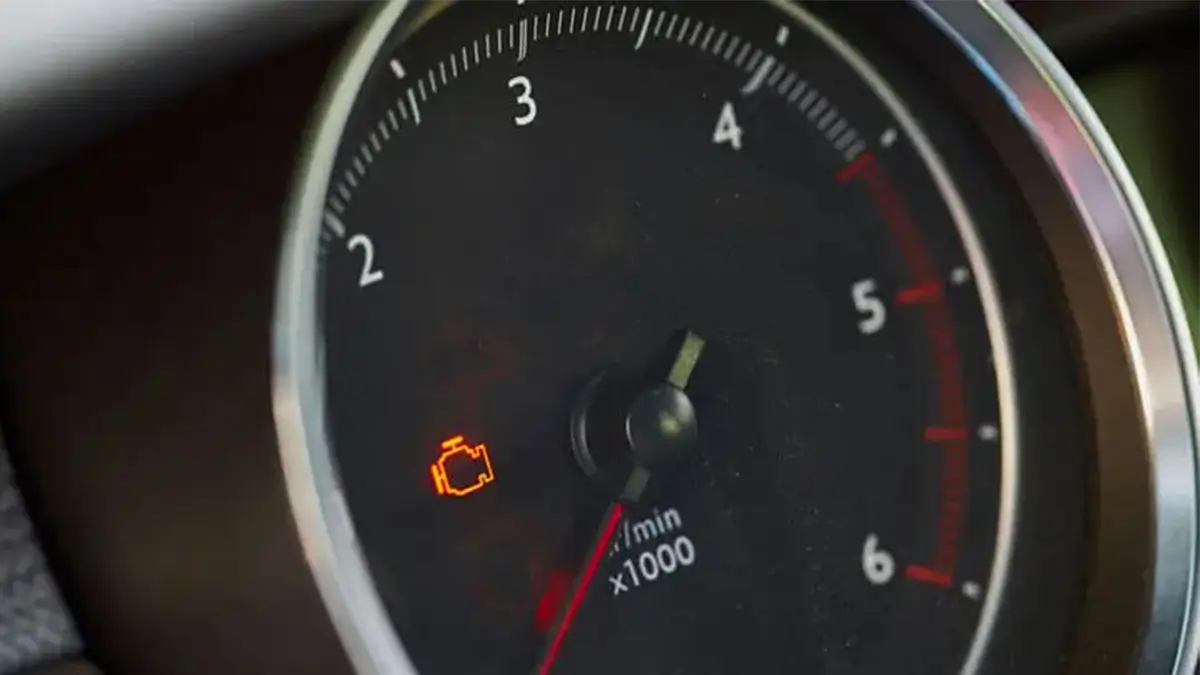The check engine light is an yellow dashboard warning light. It indicates that the vehicle has detected an issue with an engine-related component or excessive emissions.
Have you ever seen an orange check engine light on your car? This is one of the most important dashboard indicators, and it is essential to monitor it.
This light turns on when you start your car and should go off after a few moments. If it comes back on while driving, it means the engine's operation has an issue.
It is important to check the engine system to avoid problems and ensure safe driving.


Are you looking for a car scanner ?
What does the check engine light look like?
The check engine light is always yellow, categorizing it as a warning indicator. This type of light signals a detected issue in your car, but you can still continue driving. However, you should not delay fixing the problem, either by going to a garage or repairing it yourself.

This emission control warning light is represented by a stylized engine symbol. Its shape can vary depending on the vehicle model. Some cars also display the word “check” below the light.
It is a crucial indicator for monitoring engine condition and ensuring safe driving. Learn how to identify and interpret the check engine light on your vehicle!
What is the yellow engine light?
The purpose of the check engine light, also known as the "Check Engine Light" or MIL (Malfunction Indicator Lamp), is to indicate that a fault has been detected in the engine. It also warns of possible issues related to the automatic transmission or emissions control system (EGR valve, oxygen sensors, etc.).
As a driver, it is important to understand what the check engine light means and how to respond when it appears. Regular engine maintenance and inspections can help prevent issues related to the check engine light and keep your vehicle in good condition.
The check engine light and emissions control
The check engine light started appearing on dashboards in some cars in the mid-1980s when automotive electronics began to advance significantly.
Initially, the orange light indicated an engine issue, but the exact cause could only be determined using a manufacturer-specific diagnostic tool.
To pinpoint the fault, automotive diagnostics and specialized tools are essential. These tools allow you to quickly and easily identify the problem and find the appropriate solution.
If the check engine light is on during a vehicle inspection, you will be required to retest.


Are you looking for a car scanner ?
Does my car have a check engine light?
The first global emissions regulation (the OBDII standard) was passed in California. It mandated that all cars sold in California from 1996 onward must be equipped with an OBD (On-Board Diagnostics) port.
The goal of this law was to ensure that all drivers could easily determine why their car was emitting excessive pollution and to break the manufacturers' monopoly on engine data access.
Before this law, only manufacturer-specific tools could access the engine control unit and retrieve the fault code explaining why the check engine light was on.
The check engine warning light became mandatory in European cars starting in 2001.
What is the purpose of the check engine light ?
Why is check engine light on?
When the check engine light turns on, it can display in three different ways:
- Occasional flashing: Indicates a temporary engine issue. This flashing warns of potential future breakdowns, which may range from minor to severe.
- Steady illumination: The most common mode. It signals more serious problems that should be addressed as soon as possible to avoid engine damage. However, in some cases, the light may turn on due to an increase in emissions detected by the pollution control system.
- Continuous flashing: This indicates a severe engine malfunction. The issue is serious, and the engine should be turned off immediately to prevent major damage.
It is important to note that sometimes, the check engine light may turn on due to increased emissions detected by the pollution control system. To prevent breakdowns and engine malfunctions, regular vehicle maintenance is recommended.

Are you looking for a car scanner ?
How to turn off the check engine light?
This warning light may turn off on its own if the detected issue was a "false alarm"—meaning an anomaly appeared once but was not detected again.
It can also turn off after a repair, often mechanical, performed by a professional or yourself. Once the vehicle’s system no longer detects the problem, the warning light will turn off after a few driving cycles.
Finally, the light can be reset using a diagnostic scanner connected to your vehicle’s OBD diagnostic port.
Turning off the check engine light without a diagnostic scanner
Ignoring the check engine light on your dashboard is not recommended. Not performing a diagnostic scan can lead to serious consequences for your vehicle and its mechanics. If the check engine light comes on, it is crucial to consult a qualified professional to diagnose and determine the cause of the problem.
Looking for ways to turn off the check engine light without a scanner? There are tricks to do so, but we strongly advise against attempting this without identifying the root cause of the issue in your vehicle. Discover our tips and methods for clearing the check engine light using a diagnostic tool or without one!
Learn more
That’s it for this article on the check engine light. If you have any tips or questions, feel free to share them in the comments.
You can also share this article with your friends on social media!

